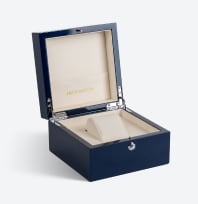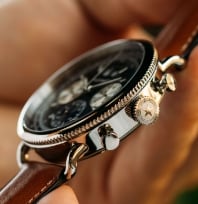Watchmakers have always sought to push the craft forward. A community of vocal and dedicated aficionados constantly pushes trends in different directions. Because style, whether based on watch movement or case size, is anything but uniform.
In the early days of watch development, complications (the other activities a watch can perform besides timekeeping) were unheard of. In an era where watches were too large even for pockets and were only accurate enough to tell the hour, progress meant better accuracy and smaller size.
Jack Mason is here to explain the hefty beginnings of the watch and the reason why thin watches became and remain desirable today.
What Makes a Watch Size?
There are many practical considerations and demands upon the size of a watch. While watch sizes are most often measured by the case size, the element which most impacts case size is that which the case protects: The movement. The movement powers the watch, and more complicated movements demand more complicated machinery.
Most ultra-thin watches, in pursuit of lightness, do away with extensive complications, returning to the root of the timepiece as a timekeeping device.
The upper limit for a thin watch is fairly generous, with any watch under 8mm being considered thin. Generally, 8mm and below watches are “thin,” 8mm to 12mm watches are average, and anything above 12mm is thick. However, although 8mm watches are considered thin, watchmakers would go much further in pursuit of the world's thinnest watch.
A History: Early Thick Watches
Ironically, the very developments that made portable watches possible also condemned them to be large, unwieldy accessories. This was due to the now-defunct fusee.
This invention was a large cone that attached to the mainspring and would serve to increase accuracy as the mainspring began to wind down. While the fusee was a groundbreaking development, it was eventually phased out due to a tendency to break, as well as the size it added to watches.
Early Thin Watches
The earliest development of thin watches came about in the 18th Century. Watchmaker Jean-Antoine Lépine, while experimenting and attempting to make pocket watches smaller, invented what would be considered the modern mechanical movement. Through much work, he was able to ditch the drum-shaped movement created by the fusee.
In 1903, a new pocket watch movement, the Caliber 145, was invented. This movement was an astonishing 1.38mm thick. While watchmakers would tinker and slowly whittle down the record for the thinnest watch, the next major event in the history of the movement came from Japan in 1969.
The Quartz Revolution
1969 was the year that quartz movements were introduced to the world. Prior to quartz, all major watch movements were mechanical in nature. Though automatic watches existed, automatic movement is a subtype of mechanical movements. Quartz watches eschewed the delicate mechanical engineering in favor of something else: Electricity.
At their core, quartz watches are battery-powered watches. The quartz crystal which gives the watch its name vibrates precisely when electricity passes through it. This powers the entire movement with a fraction of the previously needed watch parts.
With the invention of quartz, the needed interior components were simplified heavily.
The Battle for the Thinnest Watch
With a new, slender movement, it was only a matter of time before companies competed for the thinnest watch. In contemporary sizing, a watch is considered thin if it is under 8mms in thickness.
In 1979, the Delirium was introduced. This watch melded the caseback with the bottom plate of the watch movement and measured only 1.98mm in thickness. The later Delirium IV measured only .98mm. The latter watch did not feature traditional hands and was thin enough that it could not be worn without bending it.
The war of the thin watches ended ironically with a watch too impractical to wear, inverting the problems plaguing them in their early history.
Benefits To Wearing a Thin Watch
We have discussed a bit of the hubris of the industry. However, when crafted sensibly, there are numerous benefits to wearing a thin watch.
-
Comfort: Thin watches are lightweight without looking cheap. For those with smaller wrists or who simply don’t want to feel the weight of their wristwear, a thin watch can be more comfortable than a bulky one of similar case size.
-
Minimalism: Many have a strong need for the additional complications offered by sport watches. If, however, you desire a simpler watch to wear on your wrist, thin watches by nature tend to have simple, aesthetically oriented designs.
- These designs are created to take advantage of every surface while remaining as distinctively slim as possible.
-
Cost: Unless you are going for an ultra-thin watch, thin watches tend to be cheaper than their standard and oversized counterparts. There are a few reasons for this.
Firstly, many thin watches are made from smaller quartz movements, which are cheaper to make than mechanical or automatic movements.
Secondly, due to necessity, many thin watches lack other complications, making them simpler and easier to construct.
-
Style: In a market where big watches are markedly trendy and are often used as statement pieces, a thin, understated piece makes an equally powerful statement. A thin watch subverts the trend to create a daring statement.
A thin watch stands for sleekness and sophistication. It says that the wearer believes the strongest statement does not have to carry the most physical weight.
Cons of Wearing a Thin Watch
No matter the craftsmanship, no watch is universally excellent. Despite their benefits, thin watches do have a few downsides relative to their larger counterparts.
-
Durability: In eliminating all unnecessary elements, some things must be sacrificed. Thin mechanical watch movements are sometimes assembled in a way that is unstable, prioritizing thinness over construction.
Also, as previously stated in regards to the Delirium IV, some ultrathin watches are more prone to damage. Still, as long as proper care is taken, durability should not be a concern unless dealing with highly specialized thin watches.
- Simplicity: Many thin watches lack the complications or safety features demanded from a pilot or divers watch. Save the thin watch for where it can shine, and use more durable sports watches when the situation calls for them.
How To Find Your Watch Thickness
After reading this, you may want to check out a thin watch for yourself or measure the thickness of the watches in your existing collection. However, aside from the notably ultra-thin watches, pieces are usually not advertised by their thickness.
There are many ways to figure out the thickness of a watch when this information is not readily available, but these are a few of the simpler ways:
-
Check Yourself: If you have a watch physically in front of you, the simplest way to measure the thickness is to lay the case flat, then place a ruler perpendicular to the length of the case, being careful not to scratch it. The measurement should be read from the very top of the crystal.
-
Search Company Websites, and Analyze Case and Movement Size (Estimate): Note that this measurement will not always give you an exact thickness but will still help you figure out how it will fit on your wrist. Using the internet to find out more about your watch can be simple and easy.
For example, Jack Mason’s Ellum showcases a Miyota 1L45 movement, which a Google search shows has a thickness of 2.93mm. The watch also has a 40mm case size, which is on the smaller end average for cases, and suggests a potentially smaller than average thickness.
-
Inquire Directly: Many companies have on their websites the ability to contact them directly. Jack Mason, for instance, allows its users to send inquiries regarding specific watch models, whether the question is about the thickness or any other attribute.
A watch is an investment, so we encourage doing your research before finding the perfect fit for you.
How To Know if Wearing a Thin Watch Is Right For You
Ultimately, there are only two questions to ask when deciding whether or not you should wear a thin watch.
Firstly, can you physically wear it? Though there are guides that can lead you to your ideal watch size, generally, band and case size are bigger concerns than watch thickness.
The second question is simpler: Do you want to? Choosing a watch, at least where thickness is concerned, is not quite the same as choosing a shirt. Watches of nearly every thickness are available to you, but what matters most is what you feel happy and confident wearing.
Thin watches provide a sleek and slender piece of wristwear, part of a historic hunt for perfection in both form and function.
Whether you want an alternative to the bulky, complication-packed sports watches in your closet, or simply wish to express your appreciation of the simpler things in life, a thin watch makes a wonderful way to exhibit your personal style.
Sources:
How to Choose a Watch for Your Wrist Size I The Trend Spotter











